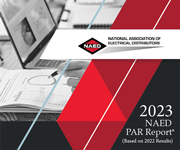By Susan Bloom
Will accelerated merger & acquisition activity continue to be the modus operandi in the lighting industry?
Earlier this year, the company formerly known as Osram Sylvania carved out its lamps business (since renamed LEDVANCE) and completed the sale of that division to a Chinese consortium. In June, GE announced that its iconic and over century-old GE Lighting division was officially up for sale, while certain long-held assets owned by Philips Lighting, including its former HID plant in Bath, NY, are also on the selling block. It seems that sale, merger, or acquisition activity in the lighting industry is ‘trending now.’
To delve into this trend further, we tapped M&A expert Ari Fuchs, Director at The DAK Group (www.dakgroup.com), a Rochelle Park, NJ-based investment bank that focuses on business sales, mergers, and acquisitions exclusively with middle market companies, for insights into this current spate of activity. With experience across many different industries as well as the lighting space, Fuchs shares his perspectives on the drivers behind the lighting industry’s (and all industries’) recent uptick in M&A activity, what these developments may mean for U.S. businesses in general, and the opportunities they can present for channel members like electrical distributors.
lightED: Why do you think there’s such an interest in M&A right now, especially in the lighting industry? Are there too many LED companies competing for the same dollars?
Fuchs: The M&A marketplace is absolutely red-hot right now and this is applicable to a number of industries in the economy. It’s being driven by several factors—among those, statistics reveal that there’s $1.7 trillion in cash currently sitting on corporate balance sheets as well as another $800 billion in un-invested private equity capital all looking for a “home” to be invested in.
In a nutshell, the marketplace is chomping at the bit to acquire solid, healthy businesses with robust growth profiles to deliver ROI to their shareholders, and they’re willing to pay top dollar to do so – overall multiples are at record highs, which has been incentivizing business owners to “cash out” and take some chips off the table. In particular, we’ve also been seeing a lot of western European interest in acquiring companies in the U.S.; however we may perceive our own economy, it’s viewed as relatively stable from a western European perspective.
Overall, companies are growing at a slow-to-moderate pace and are actively seeking M&A opportunities to enhance their growth profiles; the year 2015 represented a peak in M&A activity and, while 2016 activity was slightly down from there, it still also represented a record high that was way above average. For 2017 and into 2018, it appears that the market will continue to be very active, but any window of opportunity has a finite life span.
lightED: Where do you think this process will end? Will it be like the airlines, where there are 4 or 5 major carriers—e.g., just a few major lighting companies and then some small outsiders?
Fuchs: Once considered the ‘lighting of the future,’ LEDs are very much the technology of today, with a lot of players currently manufacturing LEDs, both domestically and offshore; as such, LEDs have become somewhat more of a commodity product that’s increasingly subject to pricing pressure.
For smaller manufacturers, the challenge will revolve around finding ways to compete with larger players that have better manufacturing economics; the question they’ll be asking themselves is whether they should be investing in/growing their business to deliver a better price/cost structure, or whether they should combine with a larger enterprise to compete more effectively in the market – e.g., do they grow or sell? Larger players will be asking – “do we want to accumulate market share by acquiring smaller players and redeploying capital into newer products?” They may use acquisitions to build market share within the existing LED market to help build and secure their own future.
Inherent in consolidation is the ongoing industry presence of larger players; it’s not clear how many players will result at the end of the road, but, as commonly demonstrated, it’s likely that 80% of the industry will continue to be controlled by 20% of the total players.
lightED: All of the research shows that the various lighting sectors (auto, emergency, street, etc.) are poised to show huge gains between now and 2023. Does this increase M&A activity?
Fuchs: Corporate and institutional capital is always looking for investments with attractive growth profiles. The lighting industry, driven in large part by the LED market, has that attribute and could indeed see a disproportionate amount of investment/acquisition capital as a result.
lightED: Do you feel that more lighting companies will try to own the entire system (e.g., controls and lighting, etc.)?
Fuchs: I do think that this dynamic will occur because, across most industries, customers or end users prefer to transact with one entity. This concept – known as the “one throat to choke” model – aims to create one vendor for all of the customer’s lighting needs, whether they involve hardware or service, and makes the transaction simpler and smoother. We’ll likely witness mergers within and between various hardware, service, and installation components/entities in the lighting industry and are actually seeing this actively occurring in many other industries.
lightED: Any advice you can offer electrical distributors relative to the current M&A landscape in the lighting industry and what they should expect? Do you feel this new landscape presents distributors with unique opportunities?
Fuchs: Given the current abundance of M&A activity, the most important lesson on the distributor side is “don’t sit idly by or remain still.” In addition to distributors accepting the fact that they’ll be selling new and/or bundled products as their suppliers continue to merge and acquire, they should also be thinking about how they might use acquisitions to build value in their own businesses – by expanding into new geographies or developing or selling different types of products or services. Every business owner will find themselves asking – “do I grow and invest capital in my own business to build value or am I at a point where I’m ready to monetize a lifetime of work, hand the reins over to someone else, and generate liquidity from the sale of my business?”
We’re in a fortunate time period where there’s a unique window of opportunity on the M&A side—a “sellers” market with lots of activity and buyers paying top dollar—but windows open and close. It’s a time for distributors to consider whether they should take advantage of the window to sell or else hunker down, reinvest, and grow.
In addition, disruptive technology is part of society now; businesses used to be able to deliver a quality product on time with a high level of customer service and feel relatively secure that customers would come back, but because the world is a smaller place now and innovation is changing the way we do business, the risk to business owners is that much greater. Distributors and all business owners need to be thinking proactively and preparing themselves. To do nothing one way or another would be a mistake.
For more information, contact Ari Fuchs at afuchs@dakgroup.com.
Tagged with acquisition, Ari Fuchs







looks like there’s no stopping Eaton from investing in any future products.
we do need to go forward for future progress